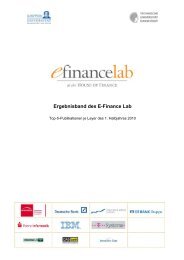Prof. Dr. Wolfgang König, Prof. Dr.-Ing. Ralf ... - E-Finance Lab
Prof. Dr. Wolfgang König, Prof. Dr.-Ing. Ralf ... - E-Finance Lab
Prof. Dr. Wolfgang König, Prof. Dr.-Ing. Ralf ... - E-Finance Lab
You also want an ePaper? Increase the reach of your titles
YUMPU automatically turns print PDFs into web optimized ePapers that Google loves.
PS1<br />
0.7<br />
0.3<br />
X<br />
PS5<br />
PS3<br />
PS2<br />
PS7<br />
Figure 1: Example Workflow (in BPMN)<br />
In addition to these functional requirements, the customers<br />
also specify their QoS needs regarding the execution of the<br />
respective workflow. For this, they provide restrictions in the<br />
form of upper or lower bounds for specific QoS parameters,<br />
the so-called Service Level Objectives (SLOs). With this<br />
information, the broker tries to select those services among<br />
functionally appropriate ones which satisfy the customers’<br />
QoS requirements, as a violation of these requirements will<br />
be penalized by the broker’s customers. Having selected respective<br />
services, the broker pays and invokes these services<br />
in order to execute the customers’ tasks and workflows, respectively.<br />
If the customers’ QoS requirements are violated,<br />
penalty fees become due, which also have to be paid by<br />
the broker. In order to reach an optimized decision, the<br />
broker models the selection of services as an optimization<br />
problem aiming at minimizing invocation cost and satisfying<br />
QoS constraints. I.e., the broker formulates an SSP, which<br />
is described in the following Section III.<br />
PS4<br />
PS6<br />
III. SERVICE SELECTION PROBLEM<br />
In order to formulate an SSP and therewith to compute<br />
an execution plan, it is necessary to aggregate the QoS and<br />
cost values of eligible candidate services according to the<br />
regarded workflow structures. For this, we specify a system<br />
model in Section III-A and discuss respective aggregation<br />
functions in Section III-B. Finally, we utilize the presented<br />
aggregation functions and provide an optimization model in<br />
Section III-C.<br />
A. System Model<br />
In this section, we describe the system model utilized in<br />
the work at hand. The set of all tasks of a workflow is<br />
labeled with I, i ∈ I = {1, ..., i # }. The set of services<br />
appropriate to accomplish a certain task i is labeled with Ji,<br />
j ∈ Ji = {1, ..., j #<br />
i }. The decision variables xij ∈ {0, 1}<br />
indicate whether a service j is selected to accomplish task i.<br />
According to our running example, we consider cost c<br />
(charge for invoking a service in cent applying a pay-peruse<br />
pricing model), response time r (time elapsed between<br />
invoking a service and receiving its response), availability<br />
a (probability that a service is available), and throughput d<br />
(number of requests a service is able to serve within a certain<br />
time interval). These parameters – in fact, even a subset of<br />
these parameters – are sufficient to cover the aggregation<br />
types summation, multiplication, and min/max-operator (cf.<br />
X<br />
PS8<br />
Section III-B). Further QoS parameters can be integrated<br />
into the optimization problem straightforwardly. Bounds for<br />
these parameters are labeled with bc, br, ba, bd.<br />
Regarding branchings, we label the set of paths with<br />
L, in which l ∈ L = {1, ..., l # } indicates the respective<br />
path number. Referring to the workflow in Figure 1, there<br />
are two paths l within the AND-block, thus L = {1, 2}.<br />
Different sets of paths will be distinguished by utilizing<br />
additional indices, i.e., La, Lx for AND/XOR. We refer to<br />
them as branching La, Lx. The tasks within a branching are<br />
covered by the set IL ⊆ I, whereas Il ⊆ IL represents<br />
the set of tasks within path l. We label the set of the<br />
remaining tasks, which are not located within a branching,<br />
with Is = I \ (Il | l ∈ L). Utilizing this system model, we<br />
develop aggregation functions in the following.<br />
B. Aggregation Functions<br />
As previously stated, it is necessary to aggregate the<br />
QoS and cost values of candidate services according to<br />
regarded workflow patterns in order to compute the overall<br />
cost and QoS for a specific workflow. Regarding our example<br />
scenario, this actually is a prerequisite for comparing<br />
workflow QoS with respective bounds issued by the broker’s<br />
customers. As previously stated, violation of the customers’<br />
bounds will result in additional penalty cost. Thus, the<br />
broker has a high interest in making sure that the customers’<br />
bounds are satisfied. For this, the broker performs a worstcase<br />
analysis as opposed to a best-case or average-case<br />
analysis. While probabilities for the execution of certain<br />
paths of a branching would be considered in an averagecase<br />
analysis, the worst (best) paths of each branching in<br />
terms of aggregated cost and QoS are considered in a worstcase<br />
(best-case) analysis for the computation of an optimal<br />
solution to the SSP. Respective aggregation functions for<br />
sequences, AND-blocks, and XOR-blocks are indicated in<br />
Table I.<br />
Table I: Worst-Case Aggregation Functions<br />
Sequence AND-block XOR-block<br />
� �<br />
� �<br />
� �<br />
rijxij max rijxij max rijxij<br />
l∈L<br />
l∈L<br />
i∈Is � j∈J �i<br />
� �i∈I<br />
l j∈J � i<br />
i∈I �l<br />
j∈J �i<br />
aijxij<br />
aijxij min aijxij<br />
l∈L<br />
i∈Is j∈J �i<br />
l∈L i∈Il j∈Ji i∈Il j∈Ji min dijxij min<br />
i∈Is<br />
l∈L<br />
j∈Ji (min<br />
�<br />
dijxij) min<br />
i∈Il l∈L<br />
j∈Ji (min<br />
�<br />
dijxij)<br />
i∈Il � � � � �<br />
� j∈J �i<br />
cijxij<br />
cijxij max cijxij<br />
l∈L<br />
i∈Is j∈Ji l∈L i∈Il j∈Ji i∈Il j∈Ji For a sequence, the cost and QoS values of all services<br />
selected to accomplish certain tasks i have to be aggregated<br />
according to the respective aggregation type, e.g., summed<br />
up for cost. Regarding AND-blocks, it has to be noted that<br />
for response time r only the path with the highest aggregated<br />
response time – the critical path – requires consideration, as<br />
the tasks within the different paths are executed in parallel.








